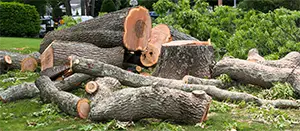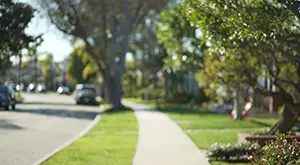 You may have seen it: a new homeowner moves in and loves the house, except for that big tree in the front yard. Before you know it, the shady spot you hid under while walking your dog is gone. After a while, you forget the tree was even there and life goes on as if nothing has changed. However, this loss affects you and your neighbors more than you think. Trees influence our community in many significant ways. Their shade can reduce temperatures by up to 9 degrees, their roots reduce flooding, and their leaves act as air purifiers. Studies have shown forested neighborhoods have reduced asthma rates, and that just spending a few minutes among trees can lower blood pressure and boost mood! And let’s not forget all the wildlife that relies on trees! These are just some of the benefits community trees provide.
You may have seen it: a new homeowner moves in and loves the house, except for that big tree in the front yard. Before you know it, the shady spot you hid under while walking your dog is gone. After a while, you forget the tree was even there and life goes on as if nothing has changed. However, this loss affects you and your neighbors more than you think. Trees influence our community in many significant ways. Their shade can reduce temperatures by up to 9 degrees, their roots reduce flooding, and their leaves act as air purifiers. Studies have shown forested neighborhoods have reduced asthma rates, and that just spending a few minutes among trees can lower blood pressure and boost mood! And let’s not forget all the wildlife that relies on trees! These are just some of the benefits community trees provide.
These benefits are reduced significantly each time a tree is removed from the community. Though the loss of these benefits may not be immediately evident when just one tree is removed, it is felt as other trees begin to fail or when several trees are removed. Eventually, stormwater fails to drain, erosion gets worse, and the ambient birdsong disappears. Walks with the dog which used to be a comfortable 78 degrees are now a sweltering 90 degrees, all the while trying to avoid puddles from last night’s storm.
The question is, why are people removing their trees? Surely the benefits outweigh the small inconvenience of an annual leaf raking. For some people, it’s a fear of the trees themselves, namely a fear of a tree falling on their cars, homes, or even themselves. While this fear is not entirely unfounded, as trees can fail in storms, this is not nearly as common as you may think. Some sources depict trees as ticking bombs just waiting to crush unsuspecting homeowners.
 In reality, a healthy, native tree can withstand all but the strongest storms and can actually protect your home from storm damage. Our native trees have evolved to the coastal weather, allowing them to emerge from most storms unscathed. Many trees that fall are already damaged, ill, or dying. These preventable tree failures have given healthy trees a bad name, resulting in increasingly barren neighborhoods. The key to a storm-resilient tree is its health, which takes less involvement on our part than you may think. In this blog series, we’ll discover just how trees protect us in storms and how to maximize the benefits they provide while having peace of mind knowing the trees in your yard aren’t going anywhere.
In reality, a healthy, native tree can withstand all but the strongest storms and can actually protect your home from storm damage. Our native trees have evolved to the coastal weather, allowing them to emerge from most storms unscathed. Many trees that fall are already damaged, ill, or dying. These preventable tree failures have given healthy trees a bad name, resulting in increasingly barren neighborhoods. The key to a storm-resilient tree is its health, which takes less involvement on our part than you may think. In this blog series, we’ll discover just how trees protect us in storms and how to maximize the benefits they provide while having peace of mind knowing the trees in your yard aren’t going anywhere.
